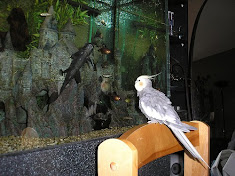 |
| Hamster Periscope by mascht_i |
If you ever attempt to handle your hamster and you notice that his ears are back then you'd better remove your hand quickly as he's feeling very aggressive and is likely to bite. Another warning sign if you ever go to handle your hamster is if you see him lying on his back with his teeth bare - you may think this a sign of submission but it's actually another sign that your hamster is frightened and he will bite you in this state if you attempt to pick him up.
Some of the more pleasant signs to look for in your hamster are burrowing and grooming. If you spot your hamster burrowing (which is very likely) it just means that he's looking for stray bits of food lying amongst his bedding material that he may have missed before. They'll spend a great deal of time doing this so it's an easy one to spot. If you catch your hamster grooming or stretching then you are looking at a particularly content and happy hamster!
If you have particularly good hearing you may occasionally catch your hamster making squeaking noises. Consider yourself lucky, as the average hamster squeak lasts only a fraction of a second, and the vast majority of hamster vocalization takes place in a frequency range that is completely undetectable by humans.
A more noticeable noise is teeth chattering - this is a sign that your hamster is unsettled, and is seen most often when a hamster is introduced to a cage that already has a hamster in it. Watch for the warning signs of potential combat between the two hamsters.
Hamsters use various scent glands on their bodies to mark their territory by rubbing the glands up against the sides of the cage. If there's a spot in the cage they wish to mark but can't get to with their glands they'll scratch their scent glands with their rear feet and then walk around the area they wish to claim as theirs. When males and females in the same cage are ready to mate they'll both reduce their markings, giving each other the signal that it's okay for the other to approach.
You may occasionally catch your hamster chewing at the bars of his cage. Although he may look like he's trying to chew his way to freedom, he's actually keeping his every-growing teeth at a reasonable length. If he didn't continue to keep his teeth ground down they'd cause serious dental problems and illness. Just make sure the bars on the cage aren't rusty!
Author Resource: Written by Adam King
Visit the Hamster-Zone website for even more detailed information on hamster care, hamster diet, hamster cages, and much, much more. Learn important tips on how to keep your hamster healthy and happy, including proper diet, care, and cage enrichment.



0 comments:
Post a Comment